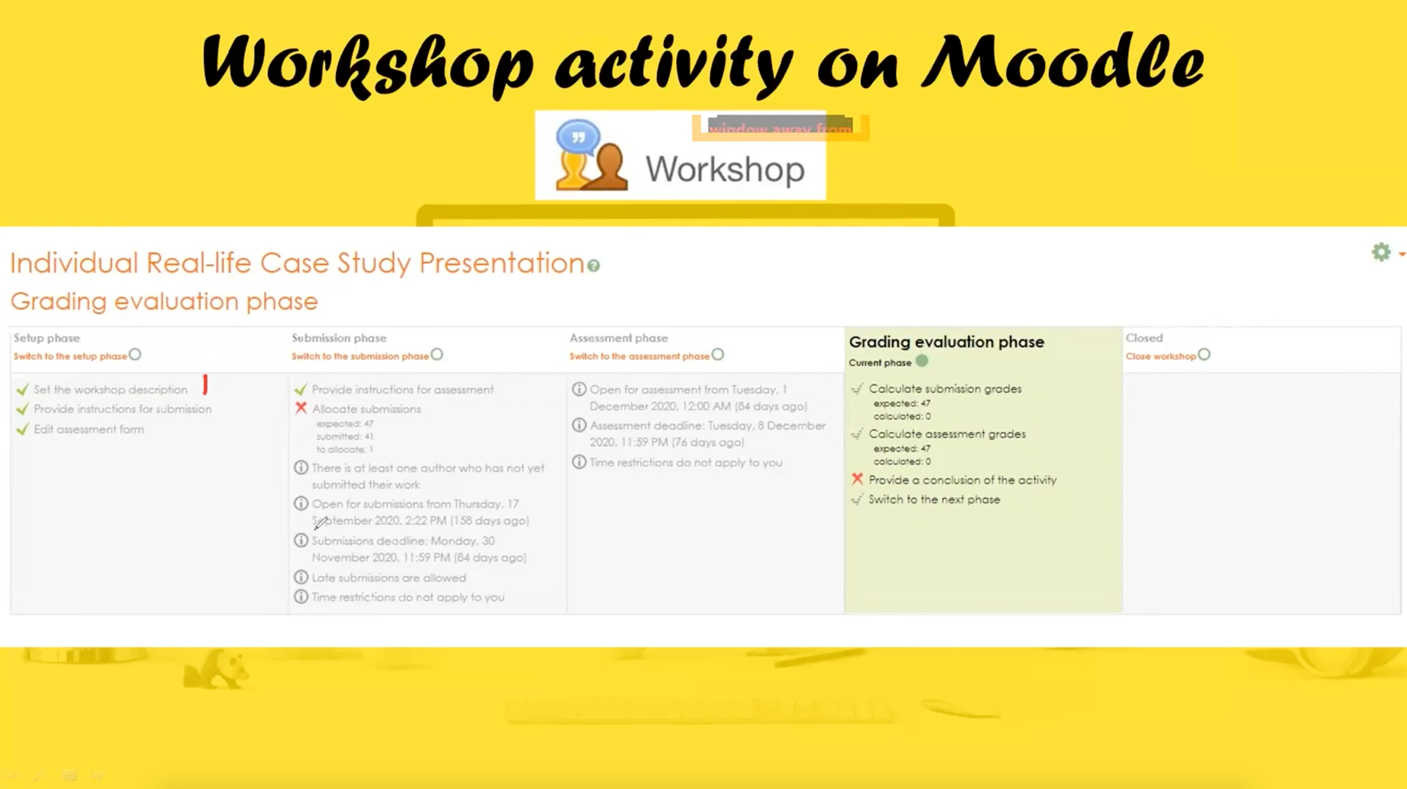Using Workshop Activity on Moodle to Organise Peer Assessment:
Sharing by Ms. Kammy Kam Mei Lau
Peer assessment has been applied in a wide variety of academic contexts to enhance students’ learning through giving and receiving comments to and from their peers. However, the logistics of peer assessment can be difficult and time-consuming. Ms. Kammy Kam Mei Lau, Lecturer from the Department of Psychology, taught PSY3018 Child and Adolescent Psychopathology in Semester 1 (2020–21). She found that “Workshop activity,” a function on Moodle, is a useful tool for arranging and managing peer assessment. This article details Ms. Lau’s experiences in using workshop activity to assign peer assessments. She also provided some tips for instructors on preparing peer assessments.
In Ms. Lau’s course, students were required to submit two assignments: an individual case study video presentation and a peer-rating assessment. The individual case study video presentation was a summative assessment. Students were asked to submit a presentation video, which showed a PowerPoint and their faces. The peer-rating assessment was based on the individual case study presentation. After the students submitted their presentation videos, each student was allocated five peers’ work to review. It was time-consuming and hard to organise the allocation, particularly when the class size was large. Fortunately, Ms. Lau discovered the workshop activity function on Moodle, which was helpful for instructors in organising peer assessment.
The workshop activity has four operation phases: Set-up, Submission, Assessment, and Grading Evaluation. The set-up phase allows instructors to establish the requirements of the assignment—for example, specifying the file format and due date. In the submission phase, students submit their work on the workshop activity. The submission phase has a reviewer allocation function. Instructors can allocate students’ work randomly or manually. In Ms. Lau’s practice, she reviewed all of the students’ presentation videos before allocation. She did the allocation manually so that she could ensure that every student would review at least one high-quality presentation video, giving them the opportunity to learn from good examples. To ensure fairness, she also arranged pairings carefully to avoid a reviewer’s work being assessed by his/her reviewee.
In the assessment phase, students submit their peer reviews. According to the students’ learning needs, instructors can ask them to submit various types of feedback, such as comments, numerical grades or the number of errors. In Ms. Lau’s course, she asked students to submit comments. She provided guidelines for students’ comments with three components: strengths, weaknesses, and improvements. When analysing their peers’ work, students needed to recall the knowledge that they gained during the course. Moreover, students were required to write constructive feedback and use their critical thinking skills (Parti, 2002). Assessing peers’ presentation videos also facilitated self-assessment using meta-cognitive skills. When students evaluated the success or failure of their peers’ work and provided suggestions, they reflected on how they could have improved their own work. After students received feedback from their peer reviewers, they judged whether the comments were reasonable and helpful for making further improvements. Ms. Lau recommended the use of peer assessment in courses to promote active engagement (autonomy and motivation) (Pope, 2001) and learner responsibility (Somervell, 1993).
Ms. Lau shared how she set up a peer assessment using a workshop activity
Based on her teaching experiences with the workshop activity, Ms. Lau shared three tips for instructors in preparing peer assessment: (1) Use Moodle Turnitin to prevent plagiarism: Workshop activity on Moodle is a strong tool for arranging peer assessment; however, the submitted files are not checked for plagiarism. To prevent plagiarism, Ms. Lau suggested that instructors might also request students to submit the original files to Turnitin. (2) Using the grading evaluation carefully: Ms. Lau was concerned about the responses of the students if part of their assignment mark was given by their peers. Hence, her students were only required to submit comments on strengths, weaknesses, and ways of improvement in the grading evaluation phase. When designing peer assessment, instructors should exercise their own discretion based on the educational needs of the course. (3) Being aware of late submissions in the submission phase: Ms. Lau shared that a few students had submitted their work just after the manual allocation of peer assessments was completed. This meant that late work was not assigned a peer reviewer. To avoid this issue, instructors could extend the length of time between the due date and the peer allocation exercise.
The workshop activity is a easy and useful educational tool for peer assessment. If you do not have experience with using it in your courses, let’s get started on this exciting adventure!
User guide: Moodle 3.9: https://docs.moodle.org/39/en/Workshop_activityReference
Patri, M. (2002). The influence of peer feedback on self- and peer-assessment of oral skills. Language Testing, 19(2), 109–131.
Pope, N. (2001). An examination of the use of peer rating for formative assessment in the context of the theory of consumption values. Assessment & Evaluation in Higher Education, 26(3), 235–246.
Somervell, H. (1993). Issues in assessment, enterprise and higher education: The case for self-, peer and collaborative assessment. Assessment & Evaluation in Higher Education, 18(3), 221–233.


